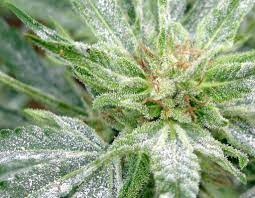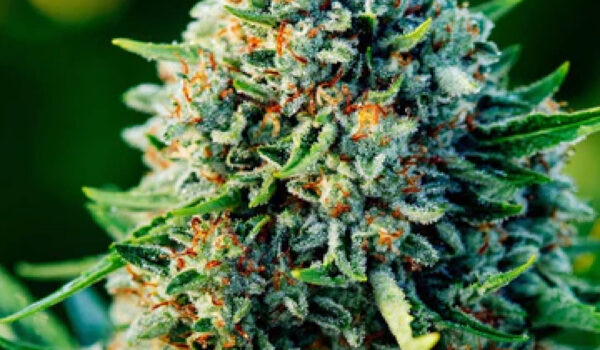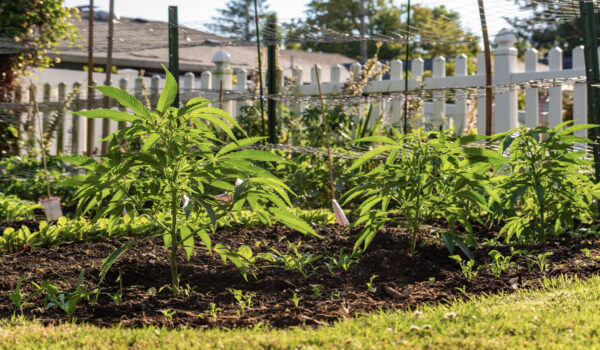
Powdery Mildew
by Rincon-Vitova Insectory
Powdery mildew (PM) is the most important fungal disease of cannabis, but also one of the most easily managed of the foliar diseases. It is a fungus that grows on the upper surface of leaves and parasitizes surface cells. Affected cells may be killed, causing brown areas on leaves; whole leaves can also be killed.
The primary symptom that is noticed is the powdery coating produced on the leaf surface which becomes prominent as infestations progress. This is made of the fungal threads (hyphae) and spores of the fungus.
Identification
The powdery coating (made of the fungal hyphae and spores) appears on the leaf surface
It may be mistaken for – and can occur at the same time as – the silk produced by spider mites.
Powdery mildews largely grow on the surface of the plant.
Life Cycle
Infections begin when a spore lands on a leaf and successfully germinates.
Germination is best if near 100% relative humidity (RH) occurs on the leaf surface,
But spores can germinate in environments down to 10-30% RH.
As the fungus grows, it produces a peg that penetrates plant cells to feeds on nutrients and continues to grow/spread.
Optimum temperature for growth is 56-64 °F but spores can survive and grow at considerably higher temperatures.
Dry spores are produced that are easily spread on winds.
Spore production can occur within a week after a plant is initially infected, allowing the disease to spread rapidly.
Monitoring
Infections tend to occur earliest on leaves in the middle or lower parts of the plant.
Conditions that favor development include high humidity, cool temperatures (below 70 °F), low light, and still air.
The powdery mildew associated with cannabis species, Sphaerotheca macularis, has a fairly wide host range.
Cultural Practices
Prevention and Quarantine
Sanitation
Warm temperatures & moderate to low humidity
Good air circulation occurs across leaf surfaces.
Fans can likely have several effects on powdery mildew:
Plants not overcrowded and regularly blown with strong air current have reduced risk of disease from PM.
However, fans will also readily allow dispersal of the dry spores.
Air current movements should not blow towards quarantine area (contaminate new plantings)
Hort oils (Sun Spray UltraFine): “paraffinic oils” highly refined petroleum-derived oils formulated to mix w water.
Neem oil- fraction from neem seed extractions – “clarified hydrophobic extract of neem oil” – also works on PM.
Neem oil has been shown to provide some level of systemic protection: applied as a soil drench.
(Neem Oil (Azadirachtin): mimics IGRs: primarily kills immature insects (they fail to complete molts). It also acts as an antifeedant & repellant. Neem also breaks down in water – don’t mix more than needed. It persists 4-8 days as foliar spray, and weeks if drenched. Neem does not harm foraging bees.
Trilogy and Triact 70 brands that have a particularly good label for use on indoor-grown herbs and spices.
Oil sprays are typically used at a 1-2% dilution in water, mixed/shaken thoroughly.
Do not use on plants that are stressed by drought do not spray under hot, dry conditions
Potassium bicarbonate & Sodium bicarbonate
Application Rate: 2-4 tablespoons (Tbsp) per gallon.
Both products act by drawing moisture from fungal stages and changing the leaf surface pH.
Page BreakPowdery Mildew
Excessive use of sodium bicarbonate may cause some risk of plant injury due to sodium build-up.
Solutions of either should be freshly prepared for each use as they degrade when standing mixed with water.
The addition of potassium/sodium bicarbonate with horticultural oils can improve spreading and coverage.
Hydrogen peroxide is sometimes suggested but there is no data to show that it is effective for powdery mildew.
Hydrogen peroxide is better used as a sanitizer; it is more effective for bacteria.
Indoors
PM needs living hosts for survival and usually dies after a few weeks without access to living plant tissues.
Disinfest growing facilities using a prolonged host-free period, including houseplants and weeds.
Exposure to ultraviolet light can also help kill powdery mildew stages.
Outdoors
Periodically washing leaves with a jet of water is useful for reducing the severity of powdery mildew
Bio-Control
Bacillus subtilis (bacteria)
Mode of action: lipids produced by the bacteria that are toxic to the fungus.
The bacteria do not have to grow on the fungus = treatment can be effective under a very wide range of conditions
(e.g., high temperature, low humidity, high light).
Application Rates: Application rates may vary among different commercial products. Read labels carefully.
Trichoderma harzianum strain T22
parasitis fungus – infects and kills other fungi.
Best used at planting/transplanting when it can be incorporated into the planting media.
Under optimum conditions roots can subsequently be protected for several weeks.
Application Rates: Application rates may vary among different commercial products. Read labels carefully.
Summary of Strategies
Sanitation
Prevention and Quarantine
Sanitation
Warm temperatures,
Moderate-low humidity
Fans – good air circulation occurs across leaf surfaces.
Potassium bicarbonate/sodium bicarbonate
Horticultural oils:
Neem oil
Potassium bicarbonate
Bacillus subtilis
Trichoderma harzianum





מחפשים דירות דיסקרטיות בבת ים ? On July 30, 2022 at 4:02 am
Everything is very open with a precise clarification of the issues. It was really informative. Your website is extremely helpful. Thanks for sharing!